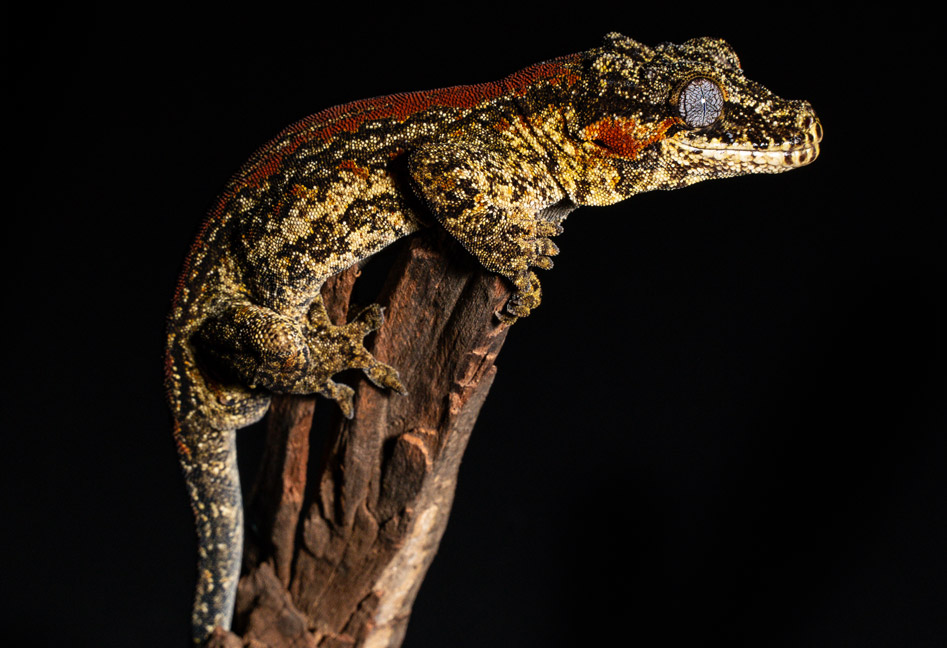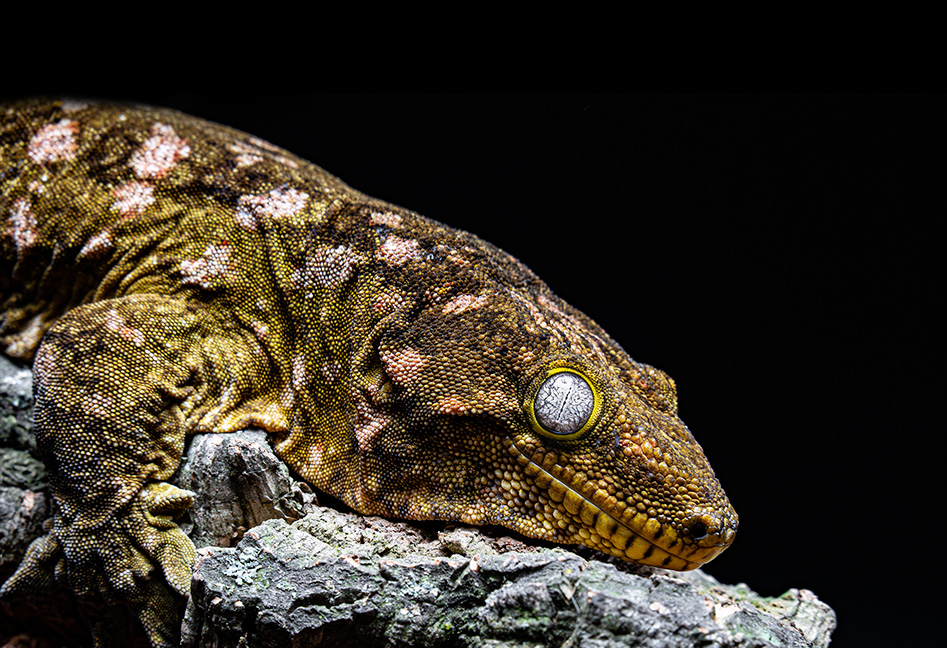Keeping
Leachianus
Origin
The New Caledonian giant gecko (Rhacodactylus leachianus) is an omnivorous, nocturnal, arboreal lizard native to the islands of Grande Terre and the Isle of Pines in New Caledonia, as well as certain small nearby islands.
The R. leachianus are the largest geckos in the world, reaching 30 to 45 cm in length. They have a large triangular head, blunt snout, lidless eyes, vertical pupils, loose velvety skin, sticky toe pads with claws and a short tail. They have a mottled pattern that gives the impression of moss or lichen, but coloration varies by subspecies. R. leachianus henkeli is the most colorful, with green, brown, gray, white, orange and pink in its color palette. Meanwhile, R.leachianus leachianus leachianus sticks to brown, black and gray.
Like other New Caledonian geckos, the R. leachianus are fairly easy to care for as far as reptiles are concerned. When well cared for, their life expectancy in captivity can be around 20 to 30 years.
Housing
Leachies are quite active and require an enclosure that is large enough to provide them with adequate opportunity to explore, hunt, and generally exercise natural behaviors. They are also arboreal, meaning they are a tree-dwelling species and require a terrarium that provides them with a generous amount of climbing space.
The minimum recommended enclosure size for R. l. leachianus should be 120x60x120cm or similar.
The minimum recommended enclosure size for R. l. henkeli should measure 90x45x90cm or similar.
They can be kept in simple set-ups (absorbent paper substrate, PVC tubes, egg cartons, etc.) or in a more elaborate bioactive terrarium (peat substrate with microfauna, cork bark, live plants, etc.).
We recommend not to house more than 1 animal per terrarium unless they are established pairs. And sometimes even in these cases you can't be 100% sure that there won't be a fight. It is necessary to make a very good adaptation of the pair to avoid fights.
Temperature and illumination
Leachianus are nocturnal and we find them most active primarily at night. This usually means that they probably prefer cooler temperatures, are exposed to low levels of indirect UVB during the day, and have exceptional night vision.
At a minimum, lighting should be provided for 12 hours per day. However, if you wish to provide seasonal cycles to stimulate the natural hormonal cycle, you can manually switch between 14 hours/day during the summer and 10 hours/day during the winter, or use a smart timer.
They do not need UVB light as long as they are supplemented with vitamin D3, but our experience tells us that they are animals that enjoy basking under a low radiation index screen (6%). UVB is the animals' natural way of doing good calcium metabolism, as well as many benefits associated with natural behavior. We always recommend adding UVB screens to our terrariums, although strictly speaking they may not need them.
These geckos need daytime temperatures of 23-24ºC (with a 27ºC zone) and nighttime temperatures of 20-21ºC. It is important for the animal's biorhythms to have diurnal rises and nocturnal drops in temperature. During the day usually with a LED spotlight on the top of the terrarium will be enough to give it a slightly warmer zone and at night it would be enough to turn off that spotlight. If the ambient temperature of your house drops below 18ºC at night it would be advisable to add a soft heat source such as a ceramic bulb or a heating cable to avoid an excessive drop in temperature that could be harmful to our gecko.
Humidity
These geckos require a moderate humidity of 60% to 85%. This can be easily achieved and maintained with one or two spraying sessions each day and a container of water inside the terrarium. An automatic rain system will ease the task of maintaining good humidity levels.
Keep in mind that the amount of time and number of times per day you spray will depend on the type of enclosure in which the geckos are kept. If your setup is naturalized, densely planted with a generous layer of substrate, the ambient humidity will practically maintain itself thanks to the transpiration of the plants. If, on the other hand, you have a more practical terrarium, with absorbent paper as substrate and some branches and artificial plants, the humidity will tend to be lower and you will have to water more frequently.
Another variable to take into account is where you live. If you are from a coastal area and the environment is generally humid you will have to spray less often than if you live in drier inland areas. Remember, these are not amphibians, so the enclosure should be moist but not waterlogged.
Feeding
Leachie geckos are omnivores, meaning they need a balanced diet of plant and animal foods to get the nutrition they need. In the wild, they feed primarily on fruits and insects.
There are many products on the market designed exclusively for feeding geckos. Preparations based on fruit, vitamins and in many cases insect meals. Brands such as Gecko Nutrition, Rhacofood diets, Repashy superfoods, Pangea,... are easy to find in stores specialized in exotics.
In Kanaky Reptiles we feed our newborns and juveniles 2 times a week with chow and 2 times with live food (being a mixed day of chow and live insects) and the adults 2 times chow and 1 live food. Younger animals can be offered food more frequently as long as they accept it, but it is not recommended to do this with adults because it can lead to obesity problems.
If you don't want to have to feed live insects in the terrarium, you can grind up frozen insects beforehand and add them to the slurry to give them that extra protein. Animals fed regularly with insects will grow faster and healthier than those that have only eaten ready-made food. It is necessary to avoid making homemade fruit mashes since they will almost certainly be deficient in many of the vitamins and nutrients necessary for the good life of these animals.
Insects such as crickets or cockroaches are the easiest to obtain and some of the best nutritionally speaking. We do not recommend the continued use of larvae such as tenebrio or zophoba. The insects offered should not be larger than the width of the gecko's head to avoid choking. When in doubt, it is better to offer a smaller insect and let it eat several.
With every live insect feeding it is essential to sprinkle with calcium and vitamin D3 supplements.
Although not crucial, we recommend providing these geckos with a container of water. Generally, crested geckos drink water by licking drops that remain on the terrarium walls, leaves or other decorative elements. However, these animals can also hydrate themselves through the cloaca. This is why it is common to find poop in the water. The animals get into the container and the water stimulates them to expel feces. If a container with water is placed in it, it is essential to change it whenever waste is seen in it, otherwise it can become a breeding ground for numerous bacteria that could generate an infection in the gecko.
If you are not going to be responsible with this issue, it is better not to put a bowl with water.
Decoration and substrates
There are many decoration options for terrariums, from the simplest with absorbent paper and some branches to the most complex bioactive set-ups.
Decorations play a vital role in your gecko's enclosure as environmental enrichment. Enrichment items encourage exercise, stimulate your pet's natural instincts and help promote overall well-being. And, of course, they make the enclosure look prettier! Without decoration, your terrarium is just a glass box with soil. Just because leachianus can climb on glass doesn't mean they shouldn't have other climbing materials available. They also need places to hide that are not on the ground.
Personally we prefer decorations that can be easily disassembled, without being glued to the bottom, as they are animals that dirty terrariums relatively quickly and being able to access for cleaning is very important. The decorative elements must be properly seated in the terrarium to avoid falls when the gecko is jumping from one place to another, as well as the plants that are placed have to be very hard as Pothos, Cheflera, Sanseviera, Croton, Monstera, ... plants that will withstand the high activity of the geckos at night.
As substrate, mixtures of coir fiber, coir chips and blond peat work very well for bioactive terrariums.






